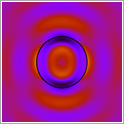Transport of nanostructured material in the interplanetary medium

The main problem we want to address in this project is related to the transport of material between two different orbits in an interplanetary environment. One possible approach is using a spacecraft to transport a given amount of material. This conservative approach presents several shortcomings in terms of costs, risks, etc. As an alternative, it is possible to exploit natural forces already available in the solar system. The most relevant forces acting on an isolated particle in the interplanetary space are: the gravitational force, the radiation force (due to the absorption and scattering of photons), the Lorentz force (resulting from the interaction between charged particles and planetary magnetic fields) and the solar wind (interaction with the corpuscular radiation expelled by the sun) [1].
The magnitude of these forces vary according to the size of the particles. When the size is small enough, the gravitational force is not dominant anymore. This means that the particle is not forced anymore to move towards the Sun, but it could eventually exploit the solar radiation to escape to a different orbit. Moreover, it is also possible to exploit some new material technologies to reduce the total scattering cross section [2], thus reducing radically the radiation force.
By engineering the particle properties (especially the size and material properties) we open the possibility to gain some control over its trajectories in space and to discover new natural pathways.
In this project, the expertise of two main scientific disciplines are brought together: nanotechnologies and mission analysis. The main three tasks to be accomplished are:
- Modeling the scattering of light by a single particle and a cluster [3]. Once the absorption and scattering are known, a reliable value of the force acting on the particle can be derived.
- Establishing the initial conditions (position and velocity) and the balance between the gravitational and the radiation ones (Β parameter) to provide some control over the particle trajectory.
- Illustrating the potential of the proposal with numerical simulations applied to some particular case studies.
References
- E. Grün, Interplanetary Dust and the Zodiacal Cloud, in Encyclopedia of the Solar System page 673, Academic Press (1999)
- A. Alu and N. Engheta, Achieving transparency with plasmonic and metamaterial coatings, Physical Review E, 72, 016623 (2005) [link]
- F. J. García de Abajo, Multiple scattering of radiation in clusters of dielectrics, Physical Review B, 60, 6086 (1999) [link]